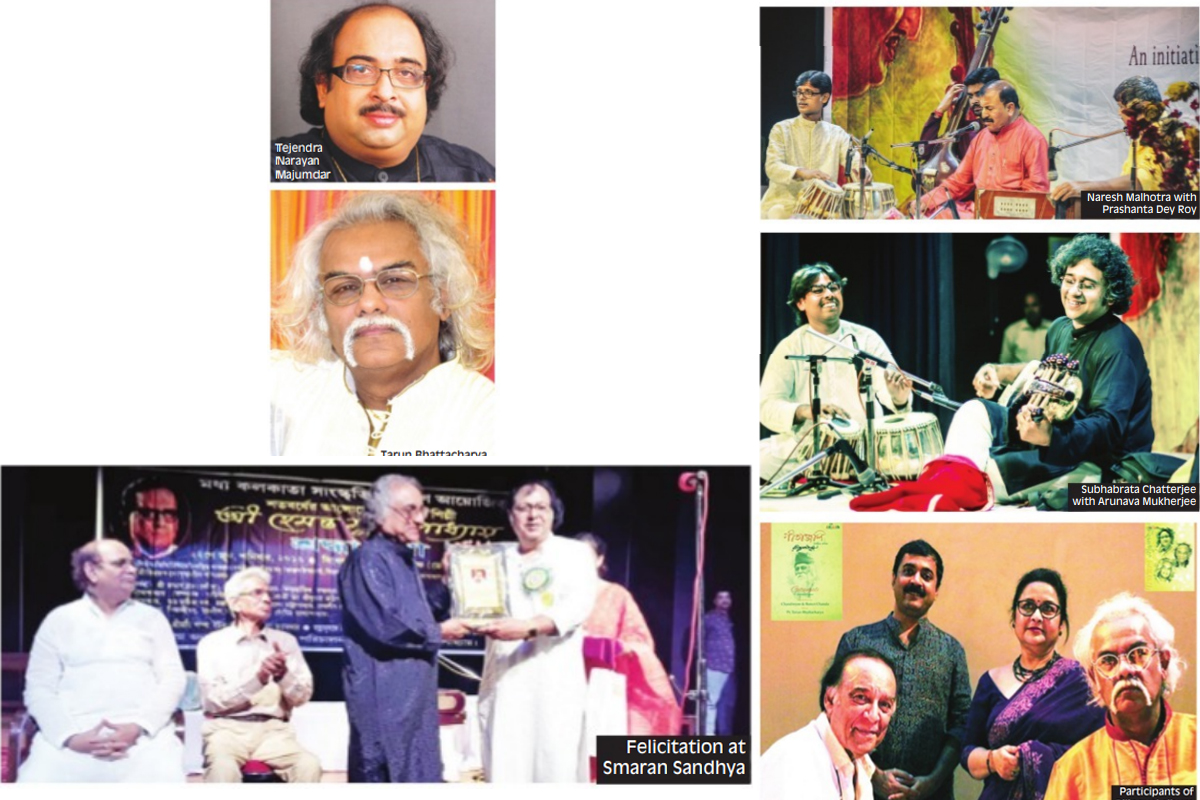‘A guru-sishiya’ relationship is the most sacred: Naidu
Naidu stressed the importance of a holistic, value-based education for the overall development of children and in building a secure future for the nation.
Being the hub of performing arts, Bengal always organises varied programmes like these, that are sure to soothe connoisseurs minds.

Photo: SNS
It is a widely accepted fact that Bengal is a jinxed zone of top ranking National Awards although the state had been gifting immensely learned and skilled performing artistes persistently during the last seven decades of independence. One prays and hopes that with the two internationally acclaimed classical musicians— sarod maestro Tejendra Narayan Majumdar and santoor maestro Tarun Bhattacharya— who won the coveted Sangeet Natak Akademi Award this year— the ominous spell will be dissipated and this musically rich state will get its due on the national scene. The news arrived on the auspicious day of Guru Purnima. Giving his reactions, Majumdar was philosophical. According to him one should be able to assess one’s own abilities— award or no award, and keep working relentlessly. “I wish to keep progressing as a better musician with the blessings of all mygurus. I dedicate this award to all my fellow musicians who have helped me evolve as a responsible performer, organiser and teacher,” said Bhattacharya. Congratulations to both the stalwarts!
Honouring teachers: For the last 20 years, on Guru Purnima, Madhyami arranges an occasion for all dedicated listeners of classical music simply because through this melodic ritual Harashankar Bhattacharya, the beacon of Madhyami, pays homage to his guruji, Abdul Halim Jaffer Khansaheb. This year, at Rabindra Okakura Bhavan, the evening began with the vocal recital of Naresh Malhotra belonging to Kirana Indore gharana. After offering his obeisance to his gurujiTejpal Singh, he chose to delineate Yaman Kalyan— an oceanic evening raga related to riyaz, romance and spirituality. The peaceful aochar carved out with elongated notes delved deep in the mandraand remained introspective. So was the easy progression of the raga, based on the lyrics of bada khayal Kajra kaise darun set to ati vilambit jhumra. The selection of words covered the lyrics of the entire sthayee very aesthetically and portrayed the pensive mood of the desolate nayikavery beautifully before applying the cajoling behlawa. There were fast solfa based taans covering octaves. The fast bol taans replete with vowel-based dynamics seemed to express the exasperation born out of an endless wait for the beloved.
Very sensitively supported by Prasanto Dey Roy’s seasoned tabla and the shadowing harmonium of Rahul Chatterjee, Malhotra very aptly selected Guru bina kaise gun gaave as his drut khayal. As per the style of his dadaguru Amir Khan’s style he always sings the first stanza of the bandishes twice. This was no exception. Short crisp sargam taans ushered in fast vowel taans that were interspersed with emotive melodic phrases. However the randomly used shudh madhyam could do better with a systematically designed phraseology. Malhotra’s next choice was raga Kalawati in the same blissfully tranquil mood. To honour requests from the audience, he concluded with a Meera bhajan.
Advertisement
This was followed by a sarod recital by Subhabrata Chatterjee— who trained under several gurus— offered his tributes to the instrument makers, especially Subhash Bhowmick along with his mentors (Dilip Patra, Kamal Mullick, Deepak Chowdhury, Partha Chatterjee and Vidushi Ameena Perera) who allowed him to absorb the beauty of Maihar gharana’s style. This was very apparent in his alap in raga Megh. The meend and gamak laden elaboration exploited the entire canvas of this seasonal ragawith superb perceptivity. The jod and jhala segments spoke high of his skilful tantrakariwhich helped him showcase brilliantly designed rhythmic patterns and fast taans.
As the prelude to the slow jhaptal gatkari, Arunava Mukherjee— disciple of Pandit Kumar Bose— came up with an impressive bayan-based piece that represented the rumbling of monsoon sky. Together they enjoyed the rhythmplay with great abandon before the sarod chose to explore raga Miyan Malhar, another powerful monsoon melody with gatkaris in slow and fast teental.
Musical tributes: A “Smaran Sandhya” was organised by the North Kolkata Sanskritik Prangan to celebrate the birth centenary of Hemanta Mukherjee, the legendary singer of Adhunik and Rabindrasangeet and an amazingly gifted composer who took both Bollywood and Tollywood by storm. The cultural evening glittered with the presence of Sujit Bose, Sidhartha Mukherjee, Kalayan Sen Barat, Alok Banerjee, Rabin Mukherjee and Soumitra Banerjee. Their glowing tributes were followed by music when Pratap Roy and Swapan Sen played instrumental versions of Hemanta Mukherjee’s compositions. Soumitra Banerjee was at his best when he sang Muchhe jawa din guli amai je pichu dake. Many celebrated singers like Goutam Mitra, Indranil Banerjee, Debasish Deb, Abhijeet Chatterjee, Debmalya Chatterjee and many others, also paid their melodic tributes by singing the immortal Hemanta-numbers. This North Kolkata based organisation was formed in 2003 under the inspired guidance of Soumitra Banerjee, who has completed 45 years of his musical journey solely dedicated to Hemanta numbers. Under his direction, this event was hosted by Madhuchanda Tarafdar and Shampa Batabyal.
Bilingual album: The bi-lingual audio album Gitanjali by Chandreyee and Barun Chanda in Bengali and English, supported by Tarun Bhattacharya’s soothing music, was released by the Atman Audio at Satyajit Ray auditorium recently by eminent personalities like Debshankar Halder (thespian), Subodh Sarkar (chairman, Kobita Academy, West Bengal), Goutam De (regional director of ICCR), Prithviraj Sen (writer). The evening also witnessed live performances by Chandreyee, Barun Chanda, Tarun Bhattacharya and several other artists accompanied by Roymans’ guitar.
Advertisement